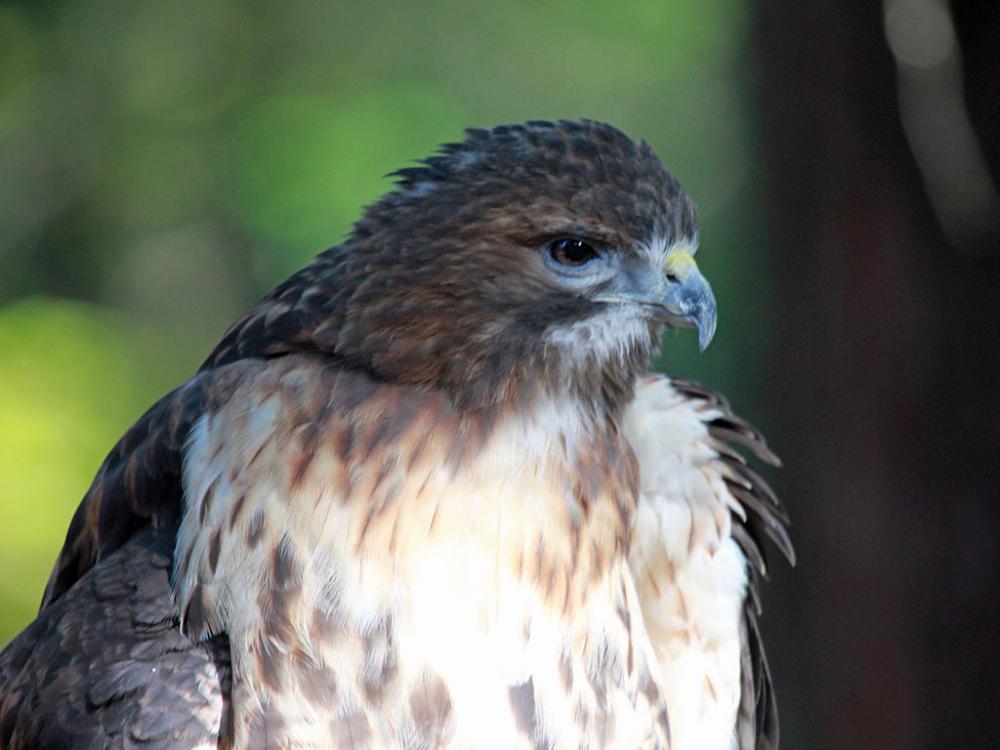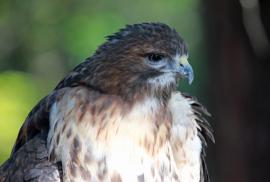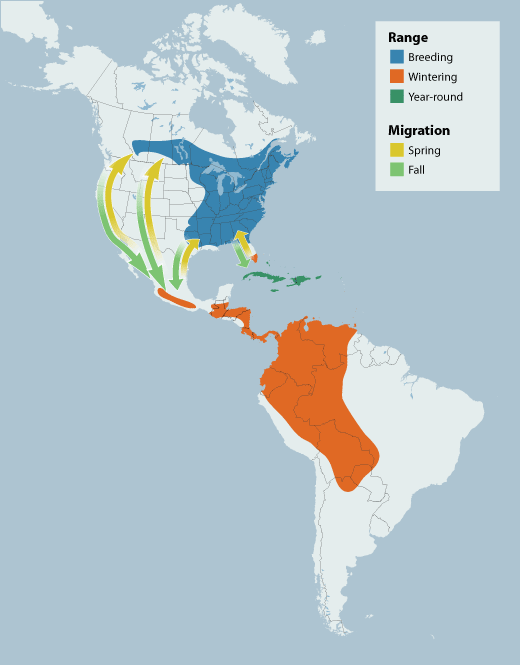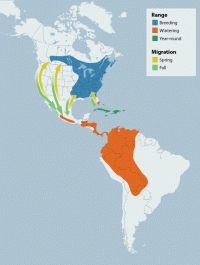Guide to Boreal Birds
This is an in-depth boreal species profile.
What is this?
This species is one of more than 30 birds selected for in-depth profiles. Find out why and see all selected boreal birds »
Overview
The Broad-winged Hawk is an eastern species, best known for its spectacular migrations; often thousands of birds travel together, with single flocks numbering up to several hundred individuals. Great numbers migrate along the eastern ridges in mid-September; more than 19,000 were counted in one day as they passed over the lookout at Hawk Mountain, Pennsylvania. During breeding, this hawk is secretive or, rather, unobtrusive. It lives mainly in the woods, beneath the canopy or hidden among the foliage. Often one is made aware of it only through its call. Its food consists mainly of snakes, mice, frogs, and insects. Despite these facts, many aspects of its ecology remain poorly understood.
Description
13-15" (33-38 cm). W. 33" (84 cm). A stocky, pigeon-sized hawk. Adult plain brown above, barred with rusty color below, with broad black-and-white tail bands. Immatures similar, but sparsely spotted or blotched below, and with tail bands less distinct.
Voice
Thin whistle, pe-heeeeeeeee?
Nesting
3 or 4 white eggs, with irregular brown spots, in a nest of sticks lined with green leaves placed in the crotch of a tree.
Habitat
The Broad-winged Hawk is essentially a forest and woodland species throughout its range and at all times of year. Only pure coniferous forests are avoided. Small canopy openings, which it uses for foraging, are an important habitat component, and it often shows a preference for undisturbed, relatively young stands near water. It may roost in arid tropical scrub during migration. Winter habitat may include plantations if sufficient prey is present.
Range/Migration
The fall migration of the Broad-winged Hawk is perhaps the best-known and most spectacular aspect of its ecology. Departing the breeding grounds ahead of most other raptors, perhaps forced to do so by scarcity of amphibian prey, it forms large flocks known as "kettles" that often number in the tens of thousands and include other raptor species. Often using thermals, most Broad-wings pass over a given area within a two-week period, though the first and last birds may be two months apart. Fall migration routes are generally somewhat east of spring routes. Most of the population passes along the Great Lakes, Appalachians, and Mississippi Valley, with smaller numbers following western mountain ranges and the Pacific coast. Long-distance water crossings are avoided. Flyways converge in south Texas, then follow the Gulf of Mexico coastline south. The winter range extends from southern Mexico to northern Argentina, with a small population wintering in south Florida and resident populations in the West Indies, where five of the six subspecies occur. Spring migration is more solitary, with few large concentrations reported outside south Texas and the southern shores of the Great Lakes; and is later than that of most raptors, again probably reflecting availability of amphibian prey.
Breeding
The breeding biology of this species is typical of the family Accipitridae. Pair formation occurs soon after arrival on the breeding grounds (mid-April to early June, depending on latitude) and includes courtship flights called "high circling," "sky-dancing," and "tumbling." The nest is a small, loose twig structure about 6 to 30 meters (18-90 ft) high, built by both birds over a period of several weeks. Two or three (rarely four) speckled and blotched white eggs are laid and incubated for 28 to 31 days. The young are brooded by the female while the male provides food for a week or two, after which both parents hunt. The nestlings fledge at 29 to 30 days and start hunting a week or two later but remain dependent on the adults until seven to eight weeks of age.
Diet/Feeding Behavior
The Broad-winged Hawk is primarily a predator of small mammals and amphibians but will eat reptiles, birds, and various invertebrates opportunistically. Prey consumption tends to reflect availability. The prominence of frogs in its diet likely explains its association with water and perhaps even its migration schedule. It is a sit-and-wait, "sentinel" predator, spending much time scanning quietly for prey from perches and then swooping on it in a manner described as "catlike." Prey is sometimes taken on the wing; dragonflies and butterflies captured in this manner likely represent a significant portion of the diet during migration. Prey is usually eaten immediately, but caching has been reported and may in fact be common.
References
Fitch, H. S. 1974. Observations of the food and nesting of the Broad-winged Hawk (Buteo platypterus) in northeastern Kansas. Condor 76:331-360.
Goodrich, L. J., S. C. Crocoll, and S. E. Senner. 1996. Broad-winged Hawk (Buteo platypterus). In The Birds of North America, No. 218 (A. Poole and F. Gill, Eds.). Philadelphia: The Academy of Natural Sciences; Washington, D.C.: The American Ornithologists' Union.
Matray, P. F. 1974. Broad-winged Hawk nesting and ecology. Auk 91:307-324.
National Audubon Society. 2002. The Christmas Bird Count Historical Results [Online]. http://www.audubon.org/bird/cbc.
Rosenfield, R. N. 1984. Nesting biology of Broad-winged Hawks in Wisconsin. Raptor Res. 18:6-9.
Rusch, D. H., and P. D. Doerr. 1972. Broad-winged Hawk nesting and food habits. Auk 89:139-145.
Sauer, J. R., J. E. Hines, and J. Fallon. 2003. The North American Breeding Bird Survey, Results and Analysis 1966-2002, Version 2003.1, USGS Patuxent Wildlife Research Center, Laurel, MD.
Credits
Birding content provided by National Wildlife Federation/eNature, with support from Ducks Unlimited/The Pew Charitable Trusts.





